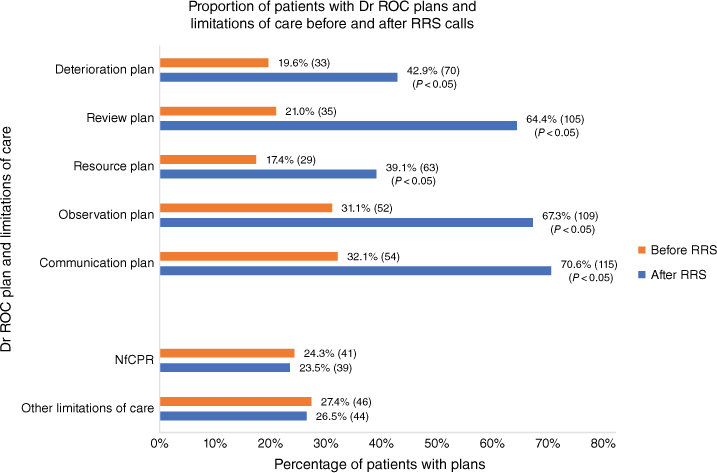Prevalence of Patient Vigilance System management plans before and after rapid response system calls
Cindy Chau A , Winston Cheung A B C * , Vineta Sahai A , Kirrilee Phillips A , Michelle Waite A , Rodney Jacobs A and Lawrence Mead AA Concord Repatriation General Hospital, NSW, Australia.
B Concord Clinical School, University of Sydney, NSW, Australia.
C The George Institute for Global Health - Australia, NSW, Australia.
Australian Health Review 47(3) 386-388 https://doi.org/10.1071/AH23074
Submitted: 11 April 2023 Accepted: 13 April 2023 Published: 4 May 2023
© 2023 The Author(s) (or their employer(s)). Published by CSIRO Publishing on behalf of AHHA.
Keywords: adult, Australia, cardiac arrest, clinical deterioration, critical care, emergency, emergency treatment, hospital, intensive care units, rapid response team.
The ‘Between the Flags (BTF)’ rapid response system (RRS), introduced in 2010, has become a standard of care in New South Wales hospitals,1 using vital signs to trigger reviews of patients at risk of deteriorating. However, increasing numbers of RRS calls since BTF inception has increased staff workload and disruption to hospital workflow without major improvements to patient outcomes.2–4
To decrease the number of RRS calls activated, we devised the Patient Vigilance System (PVS). The system prompts clinicians to detect, plan for, and manage patient deterioration before RRS calls occur (Fig. 1).
The Concord Repatriation General Hospital Patient Vigilance System (PVS) to prompt the development of deterioration, review, resource, observation, and communication (Dr ROC) plans. DNR, do not resuscitate.

Patients on the wards' electronic journey board are colour-coded according to how unwell they appear. Specific plans are then prescribed. ‘Deterioration plans’ ensure management plans are in place for predictable deterioration. ‘Review plans’ prescribe who will review the patient and when. ‘Resource plans’ ensure resources are available if required. ‘Observation plans’ instruct staff on what to watch out for, and ‘communication plans’ ensure staff and surrogate decision-makers are adequately informed. The mnemonic for this system is ‘Dr ROC’.
In planning for piloting the system at our hospital we conducted an audit of patients having RRS calls, to determine the proportion of patients who had Dr ROC management plans in place before and after RRS calls, including treatment limitations, and to determine how many RRS calls could be averted with better planning.
The single-centre prospective audit was conducted in a tertiary university teaching hospital between January 2020 and April 2021, using a paper form completed by senior nursing staff attending all RRS calls.
Of 174 RRS calls during the study period, complete data was available for 169 (97.1%) calls. The proportion of patients with plans before and after the RRS calls is shown in Fig. 2.
The percentage of patients with Dr ROC plans and limitations of care before and after RRS calls at Concord Repatriation General Hospital, January 2020 to April 2021. RRS, rapid response system; NfCPR, not for cardiopulmonary resuscitation; Dr ROC, deterioration, review, resource, observation, and communication. Comparisons were made using the Chi-squared test.

Staff indicated that 35.5% (60) of RRS calls could have been averted with better planning, and 47.3% (80) of RRS calls were reasonably predictable or expected.
Our study demonstrated three key findings. First, less than a third of patients had any Dr ROC planning before their RRS call. Second, the proportion of patients with planning for the Dr ROC categories of our PVS approximately doubled after an RRS call, implying that the RRS teams were providing a significant degree of future care planning for patients. Third, approximately one-third of RRS calls may have been averted with better planning. This generates the plausible hypothesis that implementation of our PVS may reduce the number of RRS calls, and may improve patient care through better planning.
The major limitations of this study were the small sample size and its conduct in a single centre. RRS staff were reliant on patient notes and accounts of bedside staff to determine if Dr ROC plans were in place. It is possible some patient plans may have been developed, but not communicated or documented appropriately.
Our study demonstrates that the proportion of patients with clinical plans in place using the Dr ROC categories in our PVS is significantly increased following RRS calls, indictating that RRS calls may be averted using our PVS.
Data availability
The data that support this study is available in paper form and can be shared upon reasonable request to the corresponding author.
Ethics
This study was conducted as a prospective audit that recorded de-identified patient data only. The data was collected after the events of the clinical emergency response system calls and did not impact or interfere with patient care. The data was stored in paper form in a secure, locked cupboard. Review by the Sydney Local Health District Human Research Ethics Committee - Concord Repatriation General Hospital has identified no ethical concerns in the conduct of this audit.
References
[1] NSW Government, Clinical Excellence Commission. Recognition and management of patients who are deteriorating. Sydney: Clinical Excellence Commission; 2020. Available at https://www1.health.nsw.gov.au/pds/ActivePDSDocuments/PD2020_018.pdf [cited 28 October 2022].[2] Outcomes following changing from a two-tiered to a three-tiered hospital rapid response system. Aust Health Rev 2019; 43 178–187.
| Outcomes following changing from a two-tiered to a three-tiered hospital rapid response system.Crossref | GoogleScholarGoogle Scholar |
[3] Frost SA, Chapman A, Aneman A, Chen J, Parr MJ, Hillman K. Hospital outcomes associated with introduction of a two-tiered response to the deteriorating patient. Crit Care Resusc 2015; 17 77–82.
| Hospital outcomes associated with introduction of a two-tiered response to the deteriorating patient.Crossref | GoogleScholarGoogle Scholar |
[4] Santamaria J, Moran J, Reid D. Increasing the Number of Medical Emergency Calls Does Not Improve Hospital Mortality. Crit Care Med 2018; 46 1063–1069.
| Increasing the Number of Medical Emergency Calls Does Not Improve Hospital Mortality.Crossref | GoogleScholarGoogle Scholar |


